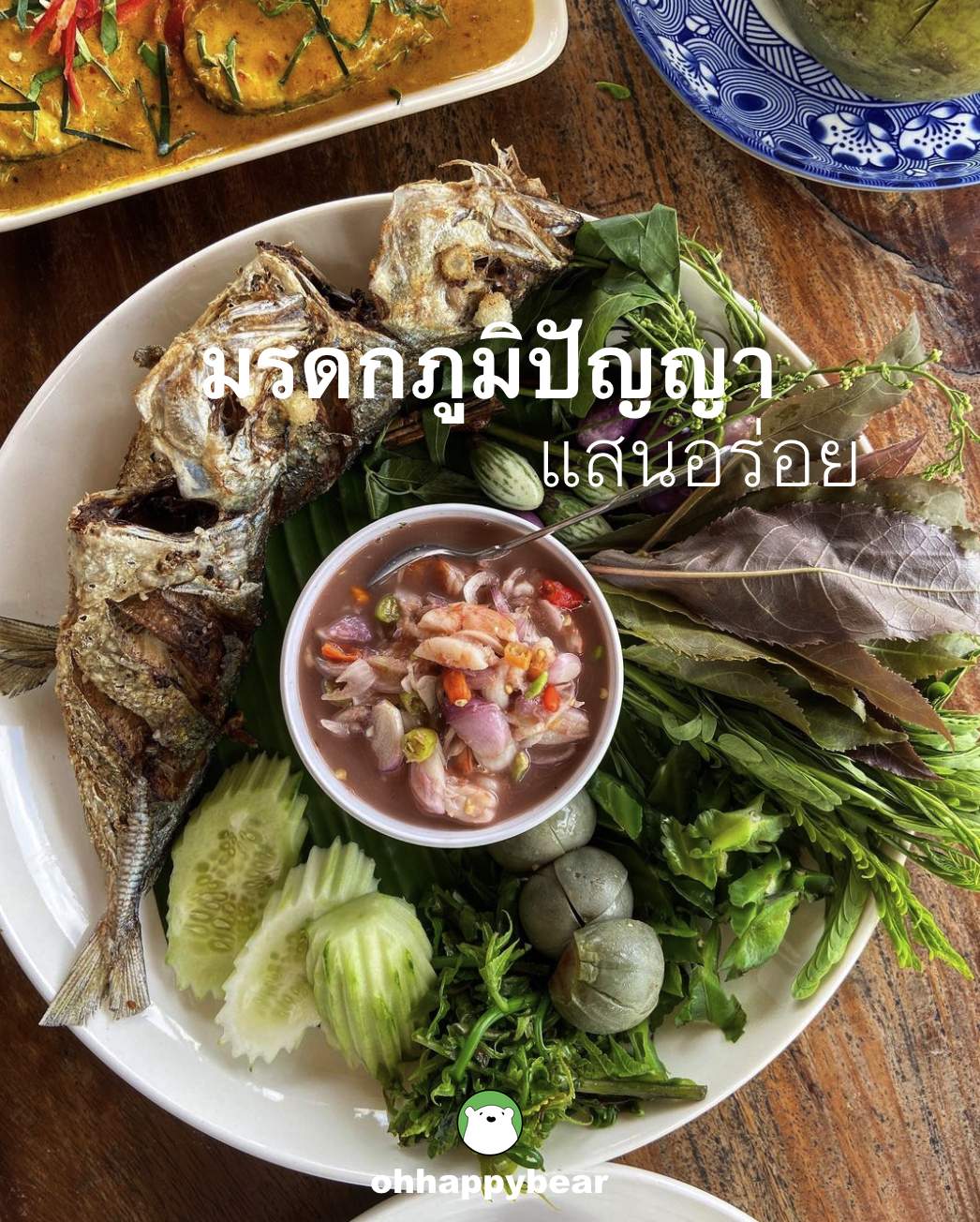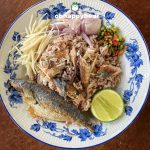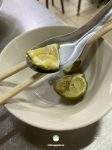(EN/TH) I’ve just found a treasure in the form of Thai dishes inscribed as National Intangible Cultural Heritage, and there are as many as 24 of them. I also found that by inscribing the original Thai cultures as such, the Ministry of Culture has created a platform for many of our cultures to be inscribed further as the International Intangible Cultural Heritage (ICH), an annual procedure at the UNESCO to celebrate and safeguard the rich and beautiful ways of life around the world.
อาหาร…เรื่องใกล้ตัว แต่มีมิติหลายด้าน ให้ลองให้เรียนรู้เท่าไหร่ไม่มีวันจบไม่มีวันเบื่อ อาหารไทยง่ายๆ ที่เรารับประทานประจำวัน ก็เต็มไปด้วยรายละเอียดมากมายที่ล้วนน่าสนใจ
เวลาเรากินข้าว หน้าตาอาหารเป็นสิ่งที่เราเห็นเป็นอย่างแรก แต่ได้พอกินแล้ว ก็มีหลายครั้งที่ตั้งคำถามว่า “อร่อยจัง คนทำเค้าคิดได้ยังไงเนี่ย เก่งจังเลยยย”
 Above: Som Tam is listed as a national intangible cultural heritage, and here is a full Isan meal including assorted somtam, larb, and sticky rice.
Above: Som Tam is listed as a national intangible cultural heritage, and here is a full Isan meal including assorted somtam, larb, and sticky rice.
ดิฉันเพิ่งพบขุมทรัพย์ที่น่าตื่นเต้นในรูปแบบของ “มรดกภูมิปัญญาทางวัฒนธรรม” การขึ้นบัญชีวัฒนธรรมไทยที่ทรงคุณค่าในแขนงต่างๆ โดยกรมส่งเสริมวัฒนธรรม กระทรวงวัฒนธรรม ที่ทำขึ้นเพื่อสร้างการรับรู้ เข้าใจ และสืบทอดวัฒนธรรมและอัตลักษณ์ไทย โดยหนึ่งในหมวดมรดกภูมิปัญญาทางวัฒนธรรมนั้น ก็คือ กลุ่ม “อาหารและโภชนาการ” โดยจากปีแรก พ.ศ. 2554 จนถึงปัจจุบัน มีอาหารที่ถูกขึ้นบัญชีแล้วกว่า 20 รายการ จากจำนวนรวม “มรดกภูมิปัญญาทางวัฒนธรรม” ทั้งสิ้น 438 รายการ ในทั้งหมด 6 หมวดหมู่ โดยอาหารและโภชนาการ ถูกจัดให้อยู่ภายใต้หมวด “ความรู้และแนวปฏิบัติเกี่ยวกับธรรมชาติและจักรวาล” พออ่านถึงตรงนี้ข้าน้อยถึงกับต้องหยุดพักขอเวลารับรู้ความลึกซึ้งสุดๆของผู้คิดเอาจริงๆอาหารนี่คือทุกอย่างในชีวิตคือจักรวาลประจำวันทุกวันของมนุษย์และทุกวัตถุดิบที่เรานำมาประกอบอาหารก็ล้วนมาจากการจัดสรรและวัฐจักรของธรรมชาติทั้งสิ้น
Listed under “Knowledge and Practices Concerning Nature and the Universe,” these Thai dishes and ingredients have proven over a long period of time to have been originally created by folks living in Thailand, and by being referred to as a part of the universe, the concept reflects the Thai deep perception that we are one with nature all along. Thai foods are delicious, of course, but with all the herbs, spices, cooking methods, and seasonal ingredients, they also nourish and heal. Many dishes, such as Tom Yum Goong, with the key ingredients of galangal, shallots, lemongrass, kaffir lime leaves, chillies, and lime, can soothe those under the weather. Try slurping a steaming bowl of any Tom Yum soup when you feel tired or are about to catch a cold, and you’ll be good to go again.
 Above: Tom Yum Goong using river prawns with their fatty parts thickening the herbal soup that is a sure way to lift one up from under the weather.
Above: Tom Yum Goong using river prawns with their fatty parts thickening the herbal soup that is a sure way to lift one up from under the weather.
ผู้รู้เรื่องนี้ได้กรุณาอธิบายให้ดิฉันฟังว่า อาหารถูกจัดให้เป็นส่วนหนึ่งของธรรมชาติและจักรวาล สะท้อนภูมิปัญญาไทยโบราณ อาหารทั้งเลี้ยงดู บำรุง และรักษาร่างกาย และยังเป็นเนื้อเดียวกันกับชัยภูมิ สภาพภูมิอากาศ ระบบดาราศาสตร์ สุริยศาสตร์ และน้ำขึ้น น้ำลง ซึ่งก็คือระบบธรรมชาติจักรวาลทั้งหมดอีกด้วยนั่นเอง
Here are the Thai dishes and ingredients inscribed as national intangible cultural heritage: 1. fish sauce 2. Tom Yum Goong 3. Pad Thai 4. Samrab Thai (a typical Thai meal with rice and assorted sides) 5. Thai red curries 6. green curry 7. Som Tam 8. chilli pastes 9. Pla Ra (fermented fish) 10. Nyonya cuisine 11. Krayasart (sticky rice crispy) 12. Khanom Bueng (Thai crispy crepes) 13. Khao Yum (southern-style mixed rice) 14. Khao Lam (sticky rice cooked in bamboo columns) 15. Khao Hom Mali (Thai Jasmine Rice) 16. Khao Tom Phad (sweet sticky rice cooked in banana leaves, shaped into pairs, and tied with bamboo threads) 17. Mangkood Kad (young mangosteens, a local snack of Nakhon Si Thammarat) 18. Miang Kham (a Thai appetizer of mixed herb rolls) 19. Gaeng Phung Pla or Gaeng Tai Pla (spicy southern-style curry with fermented fish guts) 20. coconut sugar 21. The traditional way to make fermented catfish (Pla Duk Ra) 22. Khanom Farang Kudi Chin (Kudi Chin sponge cake) 23. Pla Salid Bang Bor (Snakeskin Gourami from Bang Bo area in Samut Prakan) 24. Durian Nonthaburi.
 Above: This is Gaeng Tai Pla, a very fiery curry of fermented fish guts, Thai southern style, and my favourite. It can be paired with the sweet and milder curries served on rice vermicelli as a local southern Thai breakfast, or on its own as a side savoury with rice at lunch or even dinner. We tame its extreme spiciness with lots and lots of fresh vegetables on the side.
Above: This is Gaeng Tai Pla, a very fiery curry of fermented fish guts, Thai southern style, and my favourite. It can be paired with the sweet and milder curries served on rice vermicelli as a local southern Thai breakfast, or on its own as a side savoury with rice at lunch or even dinner. We tame its extreme spiciness with lots and lots of fresh vegetables on the side.
อาหารที่ถูกขึ้นบัญชี “มรดกภูมิปัญญาทางวัฒนธรรม” ของไทยเป็นที่เรียบร้อยแล้ว ได้แก่ 1. น้ำปลา 2. ต้มยำกุ้ง 3. ผัดไทย 4. สำรับไทย 5. แกงเผ็ด 6. แกงเขียวหวาน 7. ส้มตำ 8. น้ำพริก 9. ปลาร้า 10. อาหารบาบ๋า 11. กระยาสารท 12. ขนมเบื้อง 13. ข้าวยำ 14. ข้าวหลาม 15. ข้าวหอมมะลิ 16. ข้าวต้มผัด 17. มังคุดคัด 18. เมี่ยงคำ 19. แกงพุงปลา (แกงไตปลา) 20. น้ำตาลมะพร้าว 21. ภูมิปัญญาการทำปลาดุกร้า 22. ขนมฝรั่งกุฎีจีน 23. ปลาสลิดบางบ่อ 24. ทุเรียนนนท์
 Above: A big part of Thai cuisine is Nam Pla Prik, which is a small bowl of fish sauce (or soy sauce), chopped chillies, sliced shallots, or oftentimes garlic (optional for both) that we use to dab our bites throughout a typical Thai meal known as Samrab.
Above: A big part of Thai cuisine is Nam Pla Prik, which is a small bowl of fish sauce (or soy sauce), chopped chillies, sliced shallots, or oftentimes garlic (optional for both) that we use to dab our bites throughout a typical Thai meal known as Samrab.
โดยในแต่ละปี ชุมชนทั่วประเทศ จะทำการคัดสรร “มรดกภูมิปัญญาทางวัฒนธรรม” ท้องถิ่น นำเสนอเพื่อการขึ้นทะเบียนในระดับจังหวัด จากระดับจังหวัด ก็จะมีการคัดสรรเพิ่มเติม เพื่อเลือกขึ้นบัญชีระดับชาติ และจากระดับชาติ มรดกภูมิปัญญาที่มีอัตลักษณ์เด่นชัดและทรงคุณค่าเพียงพอก็จะถูกคัดเลือก ยื่นเสนอเข้ารับการขึ้นบัญชีให้เป็นมรดกภูมิปัญญาระดับมนุษยชาติต่อไป
The inscription of the National Intangible Cultural Heritage is an ongoing project by the Department of Cultural Promotion, Ministry of Culture, starting in 2011with 6 branches: Performing Arts (124 inscriptions), Traditional Craftsmanship (86 inscriptions), Folk Literature (53 inscriptions), Folk Sports, Games, and Martial Arts (23 inscriptions), Rituals and Festive Events (84 inscriptions), and Knowledge and Practices Concerning Nature and the Universe (33 inscriptions) in which the food and ingredients are under.
 Above: This is Miang Kham, a Thai appetizer and snack, with Bai Chaplu, or wild betel leaves, toasted coconut, dried shrimp, peanuts, chillies, and a sauce of palm sugar and tamarind.
Above: This is Miang Kham, a Thai appetizer and snack, with Bai Chaplu, or wild betel leaves, toasted coconut, dried shrimp, peanuts, chillies, and a sauce of palm sugar and tamarind.
มาถึงตอนนี้ ท่านผู้อ่านหลายท่านคงต้องร้องอ๋อ ใช่แล้วค่ะ ประเทศไทยมี “มรดกภูมิปัญญาทางวัฒนธรรม” ที่ได้รับการขึ้นทะเบียนในระดับมนุษยชาติหรือ UNESCO Intangible Cultural Heritage แล้วสามรายการ ได้แก่ โขน การนวดไทย และโนรา ซึ่งต้นเรื่องที่มาของมรดกทั้งสามนั้น ก็มาจากการขึ้นทะเบียนระดับชาติตรงนี้นี่เอง
The inscription process starts at the provincial level before moving on to the national level. Once inducted into the national lists, there will be more scrupulous to select a certain heritage to be inscribed into the International Intangible Cultural Heritage list by UNESCO. So far, there are three Thai cultures that have achieved global recognition as UNESCO Intangible Cultural Heritage. They are Khon, traditional Thai massage, and Nora dance.
เร็วๆ นี้มีดราม่าเล็กๆ เกิดขึ้นกับพะแนงของเรา ที่สื่อต่างชาตินำเสนอแต่กลับแผลงสูตร เพิ่มทั้งมะนาว ทั้งผักชี ทั้งใช้เต้าหู้ ทั้งโรยถั่วลิสงป่นลงไปในหน้าพะแนง คนไทยจำนวนไม่น้อยก็เลยเกิดอาการสะดุ้งเฮือก ตบอกผางด้วยความโมโห เห็นชัดว่าอาหารไทยกำลังอยู่ใน spotlight ของโลก และคนไทยอย่างเราๆ ท่านๆ ก็ควรจะช่วยกันเผยแพร่สิ่งที่ถูกต้องของเราออกไปด้วยจะได้ไม่เสียหาย
 Above: Nam Prik or chilli pastes three ways served in a restaurant in Phuket.
Above: Nam Prik or chilli pastes three ways served in a restaurant in Phuket.
ในการขึ้นทะเบียนอาหารให้เป็นมรดกภูมิปัญญาทางวัฒนธรรมแห่งชาติ กรมส่งเสริมวัฒนธรรมได้มีการกำหนดสูตรกลางของอาหารแต่ละจานไว้ด้วย ผู้ที่อยากทราบ เรียนรู้ ลองทำอาหารไทยแต่ละชนิดอย่างดั้งเดิมและถูกต้อง สามารถใช้อ้างอิงได้
มรดกภูมิปัญญาทางวัฒนธรรม ประกอบด้วย ศิลปะการแสดง (124 รายการ) งานช่างฝีมือดั้งเดิม (86 รายการ) วรรณกรรมพื้นบ้านและภาษา (53 รายการ) การเล่นพื้นบ้าน กีฬาพื้นบ้านและศิลปะการต่อสู้ป้องกันตัว (23 รายการ) แนวปฏิบัติทางสังคม พิธีกรรม ประเพณี และงานเทศกาล (84 รายการ) และ ความรู้และแนวปฏิบัติเกี่ยวกับธรรมชาติและจักรวาล (33 รายการ) ซึ่งอาหารและโภชนาการอยู่ในหมวดนี้
อ่านรายชื่อของ “มรดกภูมิปัญญาทางวัฒนธรรม” ระดับชาติ ระดับจังหวัด และระดับมนุษยชาติแล้ว ดิฉันนี่ทำ bucket list ของที่อยากดู อยากเห็น อยากชิมได้อีกเยอะแยะยาวยืดเลยค่ะ ?
By inscribing certain Thai dishes and ingredients as National Intangible Cultural Heritage, the Department of Cultural Promotion has also provided standard recipes for those dishes along with the stories of their origins and descriptions. Those who would like to learn more about how to make those dishes or make a bucket list out of them all are very welcome to do so.
 Above: Thai green curry of chicken and bamboo shoots served with deep-fried dried fish make a delicious and hearty Thai meal.
Above: Thai green curry of chicken and bamboo shoots served with deep-fried dried fish make a delicious and hearty Thai meal.
ข้อมูลเพิ่ม สามารถดูได้ที่เว็บไซต์ของ “มรดกภูมิปัญญาทางวัฒนธรรม” กระทรวงวัฒนธรรม ที่ https://ich-thailand.org/ หรือตามข้อมูลต่างๆ ทางวัฒนธรรมได้ที่ Facebook ของกรมส่งเสริมวัฒนธรรม
For more information about the Thai National Intangible Cultural Heritage, visit https://ich-thailand.org/. You can also connect with the Department of Cultural Promotion on their Facebook Page here.
 Above: Khanom Bueng (Thai crispy crepes) are usually available in “sweet” and “savoury” versions. The sweet is made from egg floss (Foi Thong), and the savoury is made from shrimp and coconut with pepper, cilantro, and kaffir lime leaves.
Above: Khanom Bueng (Thai crispy crepes) are usually available in “sweet” and “savoury” versions. The sweet is made from egg floss (Foi Thong), and the savoury is made from shrimp and coconut with pepper, cilantro, and kaffir lime leaves.
สำหรับสูตรอาหาร ตำนานและเรื่องราวอาหารไทยที่ถือว่าเป็นมรดกภูมิปัญญา สามารถอ่านได้ที่ หนังสือของ อ. ศรีสมร คงพันธุ์ “อาหารขึ้นทะเบียน มรดกภูมิปัญญาทางวัฒนธรรมของชาติ”
ขอให้รับประทานอย่างมีความสุขสนุกสนานค่ะ 😀 Bon Appetito!
© OHHAPPYBEAR


